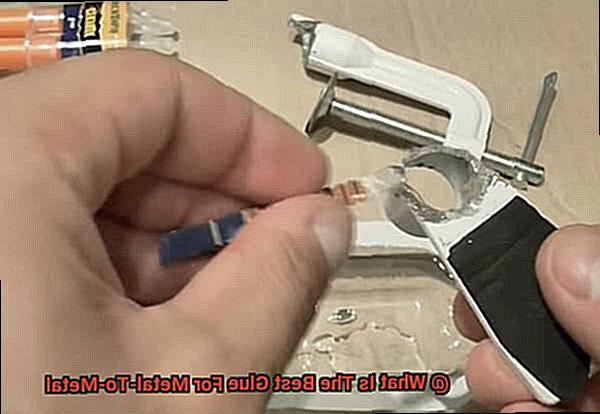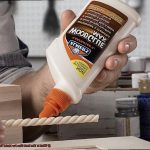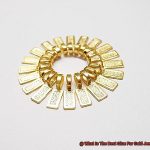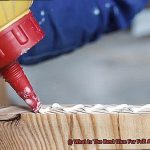Are you tired of struggling to find the right adhesive for bonding metal surfaces? It’s frustrating when your bond doesn’t hold up or your adhesive isn’t strong enough. But don’t worry, as an expert in this field, I’m here to provide you with the ultimate guide on the best glue for metal-to-metal.
Metal bonding can be a tough task, especially when you want a bond that is both strong and permanent. Luckily, there are adhesives available that can get the job done and keep those surfaces secure. In this blog post, we will explore the main types of adhesives that work well for metal-to-metal bonding. We’ll discuss their advantages and disadvantages, key factors to consider while selecting adhesives, and tips to ensure optimal results.
Whether you’re bonding steel, aluminum or any other metal surface, read on to discover which glue works best to create a firm and long-lasting bond. Say goodbye to weak bonds and hello to a sturdy connection between metal surfaces.
What to Consider When Choosing the Best Glue for Metal-to-Metal
Contents
When it comes to bonding metal to metal, choosing the right adhesive can make all the difference. Here are five key factors to consider when selecting the best glue for metal-to-metal bonding.
Metal Type
Different metals have varying properties and require specific types of glue. For example, aluminum has low surface energy and requires a glue that is designed to work with it, while stainless steel requires a glue that can handle its high corrosion resistance. Make sure you select an adhesive that is compatible with the metal type to ensure maximum bonding strength.
Strength and Durability
Consider how much stress or weight the bond will bear. A strong adhesive like epoxy may be required if the bond needs to withstand high stress or weight. However, if the bond only needs to hold up under light use, a less strong adhesive may suffice.
Environmental Conditions
The environment in which the bond will be used is also important. If the bond will be exposed to extreme temperatures or harsh chemicals, a glue that can handle those conditions should be chosen. Additionally, if the bond will be exposed to water or moisture, a water-resistant glue should be used.
Application Method
Consider the ease of application and your level of experience and skill. Some glues require mixing before application, while others come in pre-mixed tubes. Choose an adhesive that matches your application method and skill level.
Curing Time
Finally, consider how easy it is to use the glue and how long it takes to cure. Some glues require specific preparation steps before use, while others can be applied directly. The curing time can also vary significantly depending on the type of glue used. Make sure you select an adhesive that is easy to use and has a curing time that fits your needs.
In conclusion, when choosing an adhesive for metal-to-metal bonding, it’s important to consider the type of metal being bonded, the strength and durability required, the environmental conditions, application method, and curing time.
Epoxy Adhesives
Look no further than epoxy adhesives. As an expert in the field, I can attest that epoxy adhesives are some of the best glues for metal-to-metal bonding, renowned for their exceptional strength, durability, and versatility.
Epoxy adhesives consist of two components – a resin and a hardener – that work together to create a bond that can withstand high stress and extreme temperatures. These adhesives can be used to bond a wide range of metals, including steel, aluminum, copper, brass, and iron. They’re even effective for bonding dissimilar metals, such as aluminum to steel.
One of the greatest advantages of epoxy adhesives is their ability to cure under various temperature and environmental conditions. Some epoxy adhesives cure in as little as five minutes while others may require up to 24 hours. However, it’s crucial to follow the manufacturer’s instructions for proper mixing and curing.
To achieve optimum results when using epoxy adhesives for metal-to-metal bonding, it’s vital to prepare the surfaces being bonded correctly. The surfaces should be clean, dry, and free of any oil or grease. Abrading or sanding the surfaces can further enhance the bond strength.
When selecting an adhesive for your specific needs, it’s essential to consider factors such as temperature resistance, chemical resistance, and load-bearing capacity. Epoxy adhesives are ideal for metal-to-metal bonding due to their exceptional strength and durability but may not be suitable for all applications.
Polyurethane Adhesives
Polyurethane adhesives are the unsung heroes of the bonding world, providing exceptional strength and durability for metal-to-metal applications. Their unique chemical properties create a chemical reaction that results in a bond that can withstand even the toughest conditions. Here’s what you need to know about polyurethane adhesives:
Advantages:
- Exceptional resistance to impact and vibration make them ideal for heavy-duty applications that involve constant movement or high loads.
- Versatile bonding capabilities allow them to bond to a wide range of metals, including aluminum, steel, and brass.
- Excellent flexibility means that these adhesives can withstand changes in temperature and stress without cracking or breaking.
Surface Preparation:
- It’s vital to clean and degrease metal surfaces thoroughly before applying polyurethane adhesive to ensure effective bonding.
- Roughening the surface with sandpaper or a wire brush can help to improve the bond strength.

Disadvantages:
- Longer curing time compared to other types of adhesives may not be suitable for applications that require quick bonding.
- Extended curing time requires patience but ultimately results in a stronger and more durable bond.
Cyanoacrylate Adhesives
Look no further than cyanoacrylate adhesives, commonly known as superglue. As an expert in metal-to-metal bonding, I can attest to the ease and versatility of these adhesives.
One of the greatest advantages of cyanoacrylate adhesives is their simplicity. All you need to do is apply a small amount to one surface, press the two surfaces together, and hold them in place for a few seconds. Within no time, you have a secure bond. These adhesives are also compatible with a wide range of metals, including steel, aluminum, and copper. They are resistant to water and most chemicals, making them an ideal choice for harsh environments.
However, it’s important to consider the limitations of cyanoacrylate adhesives. They can be brittle and may not withstand heavy stress or high temperatures. Therefore, they may not be the best option if you require a bond that can endure extreme heat or force. Additionally, they may not work well with certain types of metals that have oily surfaces.

To ensure optimal results when using cyanoacrylate adhesives for metal-to-metal bonding, always follow the manufacturer’s instructions carefully. Clean and dry the surfaces that will be bonded and remove any oil or grease before application. Use the adhesive sparingly as a little goes a long way.
Acrylic Adhesives
Acrylic adhesives are the ultimate solution for metal-to-metal bonding. They offer an array of advantages over other bonding methods, which makes them a popular choice in various industries such as automotive, aerospace, and construction.
One of the significant benefits of acrylic adhesives is their high strength and durability. The bond created by these adhesives is so strong that it can withstand harsh environments with exposure to moisture, temperature changes, and chemicals. Additionally, they offer excellent resistance against environmental factors, making them ideal for use in challenging conditions.
Another advantage of acrylic adhesives is their ability to bond dissimilar metals. This means that they can create a strong bond between metals like aluminum and stainless steel, which are typically difficult to bond using other methods.
Acrylic adhesives can be applied using various methods like brushes, rollers, or sprays. However, before application, it’s essential to ensure that the surfaces being bonded are clean and free of any contaminants that could weaken the bond.
To achieve maximum strength, it’s crucial to follow the manufacturer’s instructions carefully. This includes mixing ratios and curing times, which may require heat or pressure during curing to achieve optimal results.
Choosing the Right Adhesive for Your Application
As an expert in this field, I know that selecting the right adhesive is key to ensuring a strong and long-lasting bond between your metal surfaces. Let’s take a look at some crucial factors to consider.
Firstly, it’s important to identify the type of metal you’re working with. Each metal has unique properties that can impact the bonding process. Therefore, you need to choose an adhesive that’s compatible with the specific types of metal you’re working with.
Environmental conditions can also affect the effectiveness of your adhesive. For instance, high temperatures, moisture or chemicals can weaken the bond. Therefore, you need to ensure that the adhesive you choose is suitable for the conditions it will be exposed to.
The strength of the bond required is another critical factor to consider. Before choosing an adhesive, ask yourself whether you need a temporary or permanent bond. This will help determine which type of adhesive is best suited for your application.
Now, let’s explore some popular types of adhesives used for metal-to-metal bonding. Epoxy and cyanoacrylate (super glue) are well-known for their strong bonding capabilities. However, they may not be suitable for all applications.
Polyurethane adhesives offer a strong bond and flexibility, making them ideal for applications that require some movement between bonded surfaces. Acrylic adhesives are known for their durability and resistance to moisture and chemicals, making them perfect for outdoor use or in wet environments. If you need an adhesive that can withstand high temperatures, silicone adhesives may be the best choice.
It’s essential that you select an adhesive that’s specifically designed for metal-to-metal bonding and follow the manufacturer’s instructions carefully for optimal results.
Factors to Consider When Using Glue on Metals
If you’re planning to glue metals together, it’s crucial to choose the right adhesive for a strong and long-lasting bond. As an expert in this field, I can tell you that there are several essential factors to consider before selecting the perfect adhesive for your metal surfaces.
Firstly, you need to know the type of metal you’re working with. Different metals have unique properties, and some may require specific adhesives to achieve a strong bond. For example, aluminum is known to expand and contract with temperature changes, making it necessary to use an adhesive with high elasticity.
Secondly, consider the environment the bond will be exposed to. Will it be subjected to extreme temperatures, moisture, or chemicals? These elements can weaken the bond over time if the wrong adhesive is used. Therefore, choose an adhesive that can withstand the anticipated environmental conditions.
Thirdly, surface preparation is crucial for achieving a strong bond. The metal surfaces must be clean and free from any oils, rust, or other contaminants that can interfere with the bonding process. Consider abrading or sanding the surface to create a rougher texture that allows for better adhesion.
Fourthly, applying the adhesive correctly is essential. Some adhesives require mixing before application, while others can be applied directly from their container. Follow the manufacturer’s instructions carefully to ensure proper application and maximum bonding strength.
Lastly, safety precautions are vital when using adhesives on metals. Some adhesives may contain harmful chemicals or emit strong fumes that require proper ventilation and protective gear during application.

Tips for Applying Glue on Metals
Bonding metal to metal can be a challenging task, but with the right adhesive and techniques, you can achieve a strong and durable bond. Here are some helpful tips for applying glue on metals.
Clean the Surfaces Thoroughly
Before applying any adhesive, it is crucial to clean the metal surfaces thoroughly. Any dirt, oil, or residue on the metal can prevent the glue from adhering properly. Using a degreaser or rubbing alcohol and a clean cloth, wipe down the surfaces to ensure they are free from any contaminants.

Roughen up the Surface
To create a stronger bond, roughening up the surface of the metal can be beneficial. You can use sandpaper or a wire brush to create small scratches on the surface of the metal. This creates more surface area for the glue to adhere to and ensures a stronger bond. Remember to wipe away any dust or debris created by roughening the surface before applying the glue.
Apply Glue Evenly
Applying the right amount of glue is essential for creating a strong bond between two metal surfaces. Too little glue may not create a strong enough bond, while too much glue can create a mess and may not dry correctly. Follow the instructions provided by the manufacturer for the recommended amount of glue.
Choose the Right Adhesive
Choosing the right adhesive is crucial for achieving success when bonding metal surfaces. Different adhesives have unique properties and advantages. Epoxy is popular for its excellent strength and durability, while cyanoacrylate (super glue) is ideal for small parts due to its quick bonding time. Be sure to research and choose the adhesive that best fits your project.
Hold in Place While Drying
After applying the glue, it is essential to hold or clamp the pieces together firmly until it has fully cured. This ensures that the bond between two metal surfaces is strong and long-lasting. The curing time can vary depending on the type of adhesive used, so be sure to read the instructions provided by the manufacturer.
sMrY7_V0I5A” >
Conclusion
In conclusion, achieving a strong and durable bond between metal surfaces requires careful consideration of several factors. The type of metal being bonded, the required strength and durability, environmental conditions, application method, and curing time are all crucial considerations when selecting an adhesive.
Epoxy adhesives are well-known for their exceptional strength, durability, and versatility. They can cure under various temperature and environmental conditions, making them ideal for bonding a wide range of metals. Polyurethane adhesives offer outstanding resistance to impact and vibration, making them perfect for heavy-duty applications that involve constant movement or high loads.
For those seeking simplicity and versatility in their metal-to-metal bonding process, cyanoacrylate adhesives (superglue) may be the way to go. However, they may not withstand heavy stress or high temperatures. Acrylic adhesives offer high strength and durability while also providing excellent resistance against environmental factors.
To achieve optimal results with these adhesives for metal-to-metal bonding, it’s crucial to prepare the surfaces being bonded correctly. Ensure that they are clean, dry, and free of any oil or grease. Abrading or sanding the surfaces can further enhance the bond strength.
When choosing an adhesive designed specifically for metal-to-metal bonding, make sure to follow the manufacturer’s instructions carefully for optimal results.






